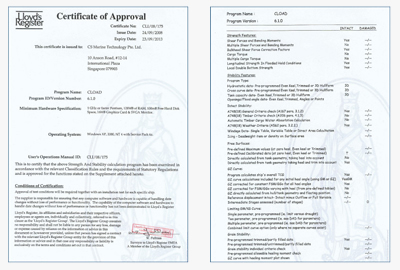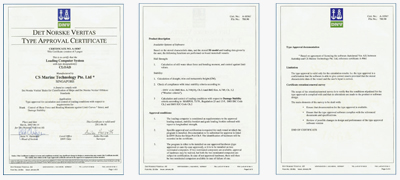Powered by industry proven three dimensional based first principle calculation engine, with over forty years history, CLOAD is an LR/DNV type approved loading instrument software (Lloyd’s Register of shipping Cert.No.CLI/08/175; Det Norske Veritas Cert.No.A-10367) and has received ship-specific approvals from most classification societies (including all IACS members).
LR Certificate
DNV Certificate
CLOAD is installed on virtually every type of vessel, offshore oil & gas platform and support utility vessel: product oil tanker, chemical tanker, liquid petroleum gas carrier, liquid natural gas carrier, bulk carrier, ro-ro vessel, car/train ferry, container vessel, multipurpose vessel, anchor handling supply vessel, platform supply/support vessel, pipe laying vessel, semi-submersibles oil rig, floating dry dock, coast guard vessel, naval vessel, cruise vessel, fishing boat, survey vessel, and more.
With the same calculation engine as Autoload/Autohydro which is originated from GHS used for ABS stability and longitudinal strength drawing approval with over forty years application and proven performance in the marine industry, CLOAD uses a complete 3D model of the vessel, identical to the model used for creating the approved stability booklet. The model includes all buoyant parts of the vessel, including tanks and void spaces. The non-buoyant superstructure is used for wind calculations.
Designed to meet IMO loading instrument requirements, CLOAD enables operators to perform proper floating status, stability and strength calculations for any kind of load condition before leaving port and at any time while at sea. CLOAD calculates stability as fuel and consumables are used, makes use of optimal ballast, and evaluates strength and stability in an intact, damaged or grounded condition. A comparison of the vessel condition can be made against preset strength and stability limits. All calculation results are derived from first principles, and therefore results are true at any displacement and at any angle of trim or heel.
CLOAD is continuously developed and improved by our sophisticated programming team with the direction from professional naval architects and operation people. The development strictly follows ISO9001:2000 Quality Management System from DNV, ensuring CLOAD’s reliability, excellent performance and competitive advantage in the marine industry.
Reports
CLOAD produces print-ready reports, including loading summary, longitudinal strength and stability. All reports can be exported to standard word processing and spreadsheet programs, or sent directly to a printer.
Customisable Program
CLOAD provides a very high degree of adaptability to meet your loading instrument requirements. Specifically, CLOAD offers the following:
- Tailoring of reports: CLOAD includes a very flexible macro language, allowing program output to be easily modified to meet your needs.
- Interface with tank and draft sensors: CLOAD reads tank and draft sensors. When on-line, tanks and drafts in the ship's model are automatically updated to reflect real conditions. You can choose to work off-line to carry out simulations.
- Integrate with vessel control systems: CLOAD can be integrated with your vessel control system. For example, the powerful analytical capabilities of our software combined with the monitoring function of your onboard control system may be used to maintain vessel draft, trim and heel within operator-specified ranges.
- Vessel Type-Specific Versions: CLOAD has several versions to meet specific vessel type requirements. Our Standard version includes all standard stability and strength functionality. The Semi-submersible version includes features required by the offshore industry rig operators, and is also used by heavy lift vessels. Our Tanker version includes petroleum and non-petroleum tanker needs.
Computer Specifications
For optimum performance, we recommend that the computer be at least: a 1 GHz or faster Pentium with 1 GB of RAM, 100MB free disk space, 16MB graphics card and an SVGA monitor. Internet Explorer version 4.0 or later is required. Operating System: Windows NT, Windows 2000, Windows XP and Vista. |


